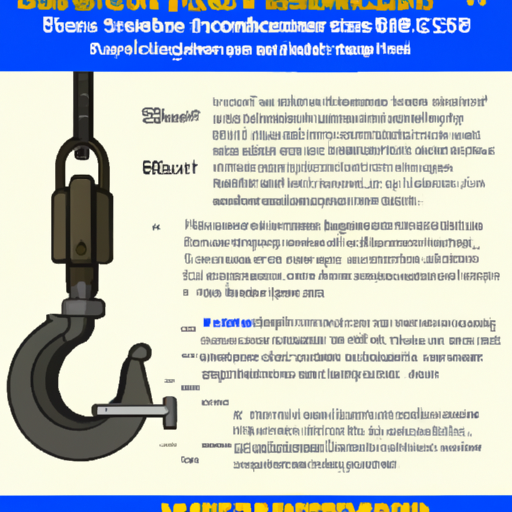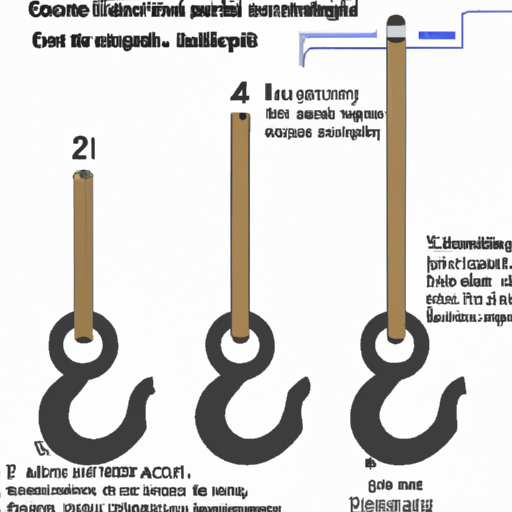
In order to ensure that your hoist system is capable of handling the weight of your load, it is essential to accurately calculate the load capacity needed. By taking into consideration factors such as the weight of the load, the distance it needs to be lifted, and the safety factor required, you can determine the appropriate load capacity for your hoist system. This article will guide you through the steps to calculate the load capacity needed for a hoist system, providing you with the knowledge and confidence to optimize the effectiveness and safety of your lifting operations.

Understanding the Meaning of Load Capacity
Definition of load capacity
Load capacity refers to the maximum weight that a hoist system is designed to lift and support safely. It is an essential metric that determines the capabilities and limitations of a hoist system. Understanding and adhering to the load capacity is crucial to ensure the safe and efficient operation of the hoist system.
How load capacity is determined
The load capacity of a hoist system is determined through various factors such as the design, materials used, and engineering calculations. Manufacturers carefully assess these factors to determine the maximum weight that the hoist system can handle without compromising safety. This information is then provided in the hoist system’s specifications, offering users a clear understanding of its load capacity limitations.
Importance of proper load capacity in a hoist system
Ensuring that the load capacity of a hoist system is appropriate for the task at hand is of utmost importance for both safety and efficiency. Overloading a hoist system can lead to catastrophic failure, resulting in accidents, injuries, and damage to property. On the other hand, underutilizing the load capacity can limit productivity and waste resources. Therefore, correctly understanding and adhering to the load capacity of a hoist system is crucial for smooth operations and maintaining a safe working environment.
Types of Hoist Systems
Manual hoist systems
Manual hoist systems are operated using human power, typically through chain or lever mechanisms. They are often lightweight and portable, making them suitable for smaller loads and limited spaces. The load capacity of manual hoist systems varies depending on the specific model and design. These systems are commonly used in industries such as construction, maintenance, and small-scale manufacturing.
Electric hoist systems
Electric hoist systems utilize electric motors to lift and lower heavy loads. These systems are efficient, precise, and capable of handling significant weights. electric hoist systems often have higher load capacities compared to manual systems, making them suitable for industrial applications with larger loads and heavier materials. They are commonly used in manufacturing facilities, warehouses, and construction sites.
Hydraulic hoist systems
Hydraulic hoist systems use fluid pressure to generate the necessary force for lifting and lowering loads. These systems are known for their exceptional lifting capacity and versatility. Hydraulic hoists can handle extremely heavy loads and are commonly found in industries such as automotive, shipbuilding, and heavy machinery. The load capacity of hydraulic hoist systems is typically determined by the hydraulic pressure and the design of the system’s components.
Factors Influencing Hoist System Load Capacity
Weight of the load
The weight of the load being lifted is a fundamental factor in determining the appropriate load capacity of a hoist system. It is essential to accurately assess the weight of the load, including any additional accessories or attachments, to ensure that the chosen hoist system can handle it safely and efficiently.
Size of the load
The size of the load being lifted can also influence the load capacity of a hoist system. While weight is a primary consideration, the dimensions and shape of the load can affect the stability and balance during lifting operations. Irregularly shaped or oversized loads may require a hoist system with a higher load capacity to ensure safe handling.
Hoist system structure
The design and construction of a hoist system play a crucial role in determining its load capacity. Factors such as the materials used, the configuration of the lifting mechanism, and the strength of the supporting components all contribute to the system’s overall load capacity. It is important to select a hoist system that is built to withstand the specific demands of the intended application.
Environment and usage frequency
The environment in which a hoist system operates and its frequency of use can also impact its load capacity. Harsh environmental conditions, such as extreme temperatures, humidity, or corrosive substances, can affect the integrity and performance of the system. Additionally, frequent and continuous use of a hoist system may lead to wear and tear, potentially reducing its load capacity over time. Considering these factors is essential when determining the appropriate load capacity for a hoist system.
Methods for Calculating Load Capacity
Using manufacturer’s specifications
One of the simplest and most reliable methods for determining the load capacity of a hoist system is by referring to the manufacturer’s specifications. Manufacturers thoroughly test their hoist systems to determine their maximum load capacity, and this information is typically provided in product manuals or documentation. By following the manufacturer’s guidelines, users can ensure they are operating within the safe limits of the hoist system.
Conducting load tests
Load testing involves subjecting the hoist system to loads that closely simulate real-world working conditions to determine its actual load capacity. This method is especially useful when dealing with custom-built or modified hoist systems that may not have readily available load capacity specifications. Load tests should be performed by trained professionals following established safety protocols to ensure accurate and reliable results.
Mathematical calculations for load capacity
In certain situations, load capacity can be calculated using mathematical formulas based on the properties and characteristics of the hoist system and the load being lifted. This method requires a thorough understanding of engineering principles and may involve considering factors such as tensile strength, leverage, and safety factors. Mathematical calculations should only be performed by qualified professionals with the necessary expertise.

Details about Manufacturer’s Specifications
Where to find specification details
Manufacturer’s specifications for load capacity can typically be found in product manuals, datasheets, or on the manufacturer’s website. It is important to obtain accurate and up-to-date specifications specific to the exact model of the hoist system being used. If any doubts or questions arise regarding the load capacity, reaching out to the manufacturer’s customer support or technical team can provide the necessary clarification.
How to read specification details
When reading manufacturer’s specifications, it is essential to pay attention to the load capacity information provided. This typically includes the maximum weight that the hoist system can lift and any relevant restrictions or conditions associated with that capacity. Users should also be aware of any implications, such as reduced load capacity at certain operating angles or with specific attachments. Understanding and complying with the specified guidelines is crucial to ensure safe and efficient use of the hoist system.
How manufacturers derive their load capacity data
Manufacturers determine the load capacity of hoist systems through rigorous testing and engineering calculations. These processes involve subjecting the hoist systems to various loads, monitoring performance, and assessing the limits of the components and structural integrity. Additionally, manufacturers consider factors such as safety margins, system redundancy, and industry standards when determining load capacities. This comprehensive approach ensures that the load capacity specified by the manufacturer is accurate and reliable.
How to Conduct Load Tests for Hoist Systems
Safety protocols for load testing
Load testing is a critical process that should be performed with strict adherence to safety protocols. Prior to conducting load tests, it is essential to ensure that the testing area is clear of personnel and any potential hazards. Personal protective equipment (PPE), such as hard hats, safety glasses, and gloves, should be worn by those involved in the testing. Additionally, all load tests should be carried out under the supervision of experienced personnel who are well-versed in load testing procedures.
Equipment needed for load testing
Load tests require specific equipment to accurately measure and apply the desired load. This may include weights, load cells, dynamometers, or other testing devices capable of measuring the force exerted on the hoist system. Additionally, appropriate rigging equipment, such as slings or shackles, should be selected according to the intended load and applied correctly to ensure a safe and controlled load test.
Procedures for conducting load tests
Load tests should be conducted methodically and according to a predetermined plan. This plan should outline the intended load, the duration of the test, and any specific conditions or parameters that need to be monitored or met. The load should be gradually increased, allowing adequate time to monitor the hoist system’s performance and assess any signs of stress or strain. Throughout the test, detailed records should be kept, documenting the applied load, performance observations, and any other relevant information. Proper analysis of the test results will help determine the accurate load capacity of the hoist system.

Using Mathematical Calculations to Determine Load Capacity
Formulas used in load capacity calculation
Mathematical calculations for load capacity often involve analyzing the various forces and mechanical properties of the hoist system. The specific formulas used depend on factors such as the type of hoist system, its design, and the load being lifted. For example, calculations may involve considerations of working load limits, safety factors, tensile strength, or lever principles. Consulting industry standards, engineering references, or seeking assistance from a qualified professional can ensure accurate and reliable load capacity calculations.
Importance of accurate measurements
Accurate measurements of various parameters, such as weight, dimensions, and angles, are crucial when using mathematical calculations to determine load capacity. Even slight inaccuracies can significantly impact the calculated load capacity and potentially compromise the safety and performance of the hoist system. Therefore, it is important to use calibrated equipment and ensure precise measurements to obtain reliable results.
Common errors in calculation
When using mathematical calculations to determine load capacity, it is essential to be aware of common errors that can occur. Some of these errors include incorrect or incomplete data input, improper use of formulas or conversions, or failure to account for all relevant factors. Careful attention to detail, double-checking calculations, and verifying results against manufacturer’s specifications or load test data can help mitigate these errors.
Implications of Overloading a Hoist System
Potential damage from overloading
Overloading a hoist system beyond its load capacity can have severe consequences. Components and structural elements of the hoist system can experience excessive stress, leading to deformation, buckling, or failure. This can result in costly repairs, downtime, and potential damage to the load being lifted or the surrounding environment. Additionally, overloading poses a significant safety risk to personnel operating the hoist system and those in the vicinity.
Risk of accidents and injuries
Overloading a hoist system significantly increases the risk of accidents and injuries. The system may lose stability, causing the load to become uncontrolled or fall unexpectedly. This can result in personnel being struck by the load or being caught in the falling objects, leading to serious injuries or even fatalities. Additionally, overloading can cause the hoist system to malfunction, leading to sudden drops or uncontrolled movements that can cause accidents.
Impact on hoist system lifespan
Consistently overloading a hoist system significantly shortens its lifespan. The repeated stress and strain placed on the components and structural elements can lead to premature wear and damage. Frequent repairs or replacements become necessary, which not only incurs additional costs but also results in increased downtime. Properly adhering to the load capacity of a hoist system ensures its longevity and optimal performance over time.

Safety Measures When Using Hoist Systems
Regular inspections and maintenance
Regular inspections and maintenance are crucial for ensuring the safe and efficient operation of hoist systems. Inspection routines should be established, including visual inspections of all components, checking for signs of wear or damage, and verifying load capacity labels. Regular preventive maintenance, such as lubrication, adjustments, and component replacements, should also be performed as per the manufacturer’s recommendations or industry standards.
Proper handling and operation of the hoist system
Proper handling and operation of a hoist system play a vital role in maintaining a safe working environment. Operators should be appropriately trained in using the hoist system, following correct procedures, and adhering to the load capacity limitations. They should also avoid sudden movements or jerks during lifting or lowering operations, as these can significantly impact the stability and safety of the hoist system.
Training and equipment for operators
Providing adequate training to hoist system operators is essential for their safety and the efficient use of the equipment. This training should cover topics such as load capacity understanding, proper rigging techniques, recognizing potential hazards, and emergency procedures. Operators should also be provided with appropriate personal protective equipment (PPE), such as hard hats, safety glasses, and gloves, to minimize the risk of injury during hoist operations.
Maintaining Optimal Load Capacity over Time
Factors leading to diminished load capacity
Various factors can contribute to diminished load capacity over time. Continuous use, exposure to harsh environmental conditions, lack of maintenance, or improper handling can all contribute to the degradation of hoist system components. Additionally, modifications or repairs made without considering the impact on load capacity can potentially compromise the system’s performance. Regular inspections, maintenance, and adherence to load capacity guidelines are crucial in preserving the optimal load capacity of a hoist system.
Methods for enhancing load capacity
Enhancing the load capacity of a hoist system should be approached with caution and in consultation with the manufacturer or qualified professionals. Changing specific components, such as upgrading the lifting mechanism or reinforcing structural elements, may help increase load capacity, depending on the system’s design. However, any modifications made must comply with industry standards and safety regulations to ensure that the enhanced load capacity does not compromise the overall integrity and safety of the hoist system.
Role of regular maintenance in maintaining load capacity
Regular maintenance plays a vital role in maintaining the load capacity of a hoist system. By adhering to scheduled lubrication, inspection, and maintenance routines, potential issues can be identified and addressed promptly. Over time, these proactive measures help prevent premature wear and damage, enabling the hoist system to consistently operate at its optimal load capacity. Regular maintenance not only ensures the longevity of the hoist system but also contributes to the safety and efficiency of the operations it supports.
In conclusion, load capacity is a fundamental aspect of hoist systems that should never be overlooked or underestimated. Understanding the load capacity, adhering to the manufacturer’s specifications, and conducting proper load tests or calculations are essential for safe and efficient operation. Overloading a hoist system can have severe consequences, including accidents, injuries, and damage. By following safety measures, conducting regular inspections, and proper maintenance, hoist system operators can maintain optimal load capacity and ensure a secure and productive working environment.










